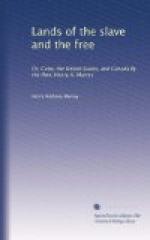I am aware that residents in these breeding States are to be found who would scorn to utter a wilful falsehood, and who deny this propagation of the human chattel for the flesh market; but there can be little doubt that the unbiased seeker after truth will find that such is the case. And why not? Why should those who make their livelihood by trafficking in the flesh of their fellow-creatures hesitate to increase their profits by paying attention to the breeding of them? These facts do not come under the general traveller’s eye, because, armed with letters of introduction, he consorts more with worthy slave-owners, who, occupied with the welfare of those around and dependent upon them, know little of the world beyond; in the same way as in England, a Christian family may be an example of patriarchal simplicity and of apostolic zeal and love, and yet beyond the circle of their action, though not very far from its circumference, the greatest distress and perhaps cruelty may abound. How many of the dark spots on our community has the single zeal of the Earl of Shaftesbury forced upon the public mind, of which we were utterly ignorant, though living in the midst of them. The degraded female drudge in a coal-pit, the agonized infant in a chimney, and the death-wrought child in a factory—each and all bear testimony to how much of suffering may exist while surrounded by those whose lives are spent in Christian charity. And so it is in every community, Slave States included. Christian hearts, pregnant with zeal and love, are diffusing blessings around them; and, occupied with their noble work, they know little of the dark places that hang on their borders. The Southern planter and his lady may be filled with the love of St. John, and radiate the beams thereof on every man, woman, and child under their guardianship, and then, “measuring other people’s corn by their own lovely bushel,” they may well hesitate to believe in the existence of a profligate breeding Pandemonium within the precincts of their immediate country. Yet, alas! there can be little doubt that it does exist.
Let us now fix our attention on the actual facts of the case which all parties admit. First, we have a slave population of 3,200,000. I think, if I estimate their marketable value at 80_l_ a head, I shall be considerably below the truth. That gives us in human flesh, 250,000,000l. Secondly, let us take the product of their labour. The Slave States raise annually—
Rice 215,000,000 lbs. Tobacco 185,000,000 " Sugar 248,000,000 " Cotton 1,000,000,000 " Molasses 12,000,000 gallons. Indian Corn. 368,000,000 bushels.
Estimating these at a lower value than they have ever fallen to, you have here represented 80,000,000l. sterling of annual produce from the muscle and sinew of the slave.[BW] Surely the wildest enthusiast, did he but ponder over these facts, could not fail to pause ere he mounted the breach, shouting the rabid war-cry of abolition, which involves a capital of 250,000,000_l_, and an annual produce of 80,000,000l.




